density and rapidity
DISRUPTION emerges from particulars of time and space. The character of disruption reflects innate complexity and unpredictable convergence of multiple variables.
According to demographers, since sometime in 2008 for the first time most humans are living in cities. Until the last two centuries dense concentrations of humans were limited by availability of sufficient water, supply of food, and transport/treatment of waste.
But with the invention of the steam engine and subsequent technologies it has been increasingly possible to move the massive inputs and outputs required by urban concentrations.
In 1800 Beijing, with just over 1 million residents, was the largest city in the world. In 1825 the population of London passed that of Beijing. By 1850 London’s population was 2.3 million.
In 1950 there were 83 cities in the world with populations of at least one million. Today there are over 460 million-person-plus cities.
Since 1920 the United States Census Bureau has categorized a majority of the US population as urban. Since 1960 the Census Bureau has used a 1000-person-per-square-mile definition for urban. Today over three-quarters of Americans live in urban areas.
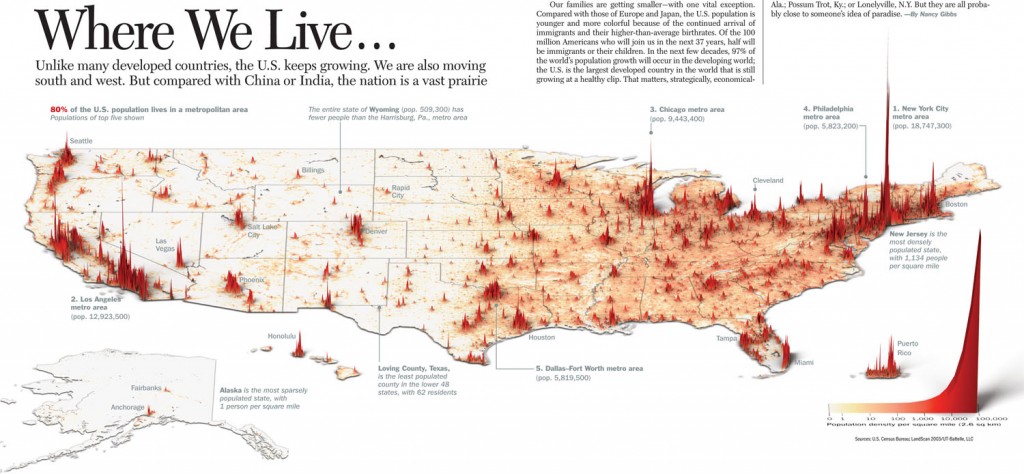
A combination of proximity and technology is transforming our experience of both time and space. According to the geographer David Harvey we have, for at least the last 30 years, experienced the “annihilation of space through time.” Paul Virilio, a French urbanist, describes a widely shared perception in which physical space is replaced with the emotional experience of “speed space.”
The Just-in-Time revolution at Toyota was implemented largely through reorganization – and often reduction —of space. Inventory was moved closer to the worker. Inventory was delivered directly to the factory floor. Inventory was made available to pull what is needed. Unnecessary inventory was removed. Warehouses became machine shops. Movement in space was measured. Movement was optimized to purposes. Non-movement attracted skeptical attention.
In the case of Toyota the implementation of Just-in-Time was facilitated by the proximity of its manufacturing plants to those of its parts suppliers. Short distances allow for compression of duration. Instead of delivering potentially needed parts to a warehouse, the suppliers deliver immediately needed parts to the factory floor. This compression was not as easily achieved if the car was being made in Dearborn and the parts were made in Dayton (200 miles distant).
Amazon does not – cannot – offer same day delivery everywhere. It currently offers one-hour delivery to specific postal codes in New York, Atlanta, Austin, Baltimore, Boston, Dallas, Indianapolis, Los Angeles, Philadelphia, Miami, San Diego, Seattle, Tampa, Washington D.C. and London. Density of population and careful placement of “fulfillment” centers (not distribution centers) allows the time-line to be compressed within a particular space.
Amazon launched its one-hour PrimeNow service just before Christmas 2014 to a set of contiguous zip codes in Manhattan. It has since expanded to a much wider pool. But the initial targeting tells a tale. Below, the green on the map to the left shows the Prime Now delivery zone on or about December 23, 2014. The map on the right shows the zip codes with the highest median income. Coincidence?
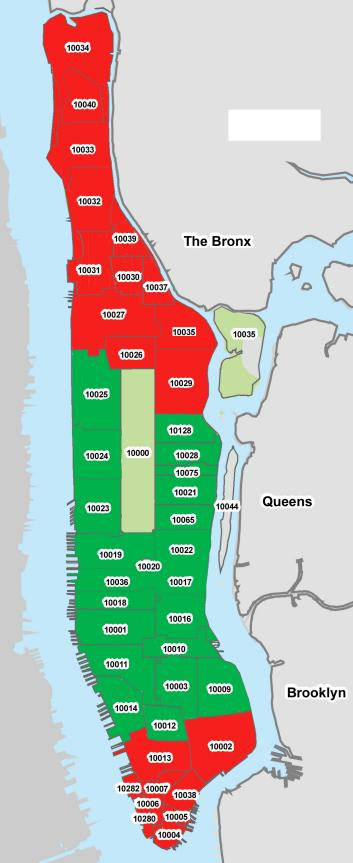
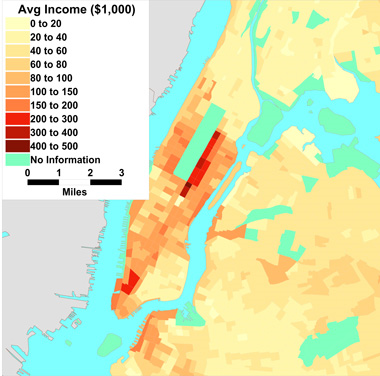
The map on the left, above, was generated by Amazon in December 2013 using the US Postal Service zip code map. The map on the right, based on 2000 Census data, was developed by Andrew Beveridge.
The second map demonstrates another kind of density. Populations follow wealth. A concentration of wealth will almost always generate a proximate concentration of population. PrimeNow is a premium-priced service. It is especially well-suited for cash-abundant, time-deficient consumers. The Upper East Side enjoys a particular concentration of such consumers. This establishes sufficient volume to sustain the service. Once sunk-costs are invested – and processes refined – to serve the primary target, it makes sense to extend the service to others that happen to be near-by. But at some distance from the locus of wealth there will no longer be sufficient pull to further reduce the time-line. Space and time unbends. Amazon is still exploring where and how these boundaries emerge and morph.
The industrial revolution tended toward geographic concentration of economic activity, typically around sources of raw material and/or energy. The post-industrial era generates a similar clustering around sources of functional expertise, ranging from speculation to logistics. In Silicon Valley an ecology of academic research, venture capital, and advanced manufacturing is very supportive of technological innovation. The Memphis and Chicago regions have seen a similar clustering of logistics expertise. In 2014 forty percent of new drugs approved by the FDA were formulated by companies located in Central and Northern New Jersey.
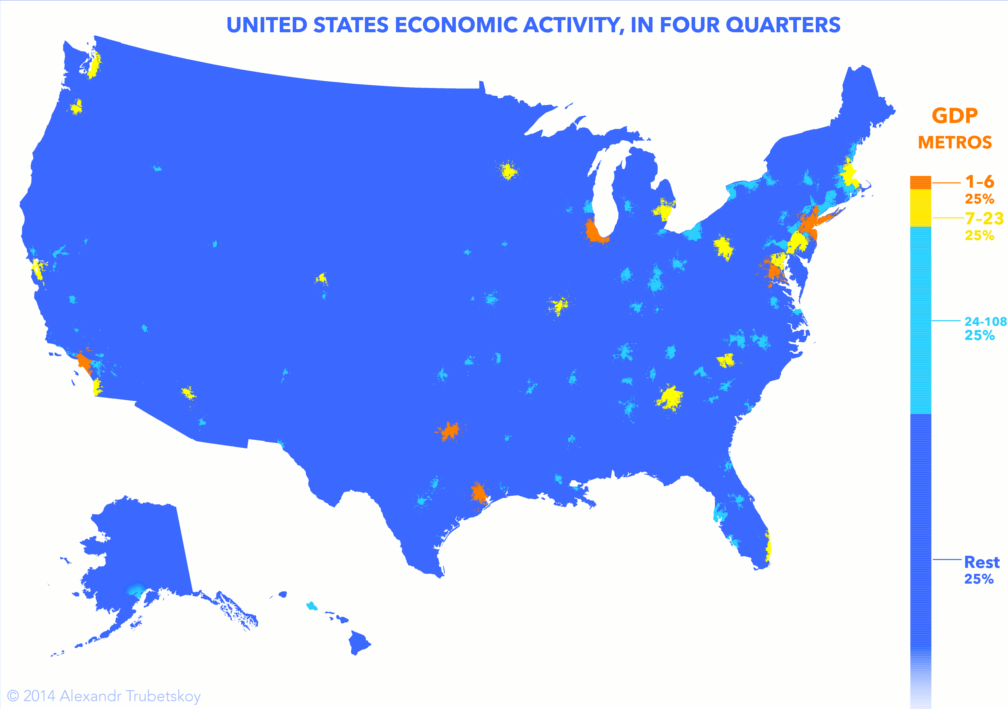
According to IHS Global Insight, six metro areas — New York, Los Angeles,Chicago, Washington D.C., Dallas and Houston — account for almost a quarter of the United States’ $16.8 trillion economy. Add in the next seventeen largest cities and roughly half the national economy is generated within a few thousand square miles of the 3.8 million square miles the United States encompasses.
Not just speed space, but dense space.

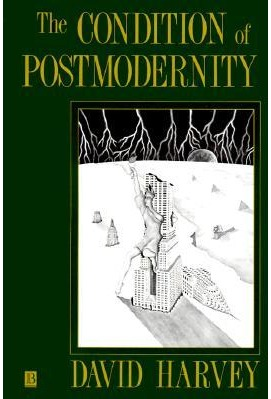
The Condition of Postmodernity by David Harvey
US Metro Economies by IHS Global Insight, 2015
World Urbanization Prospects by United Nations, Social and Economic Affairs Council, 2014
The NASA image below is a composite assembled from data acquired by the Suomi NPP satellite in April and October 2012. The image was made possible by the satellite’s “day-night band” of the Visible Infrared Imaging Radiometer Suite (VIIRS), which detects light in a range of wavelengths from green to near-infrared and uses filtering techniques to observe dim signals such as city lights, gas flares, auroras, wildfires and reflected moonlight.
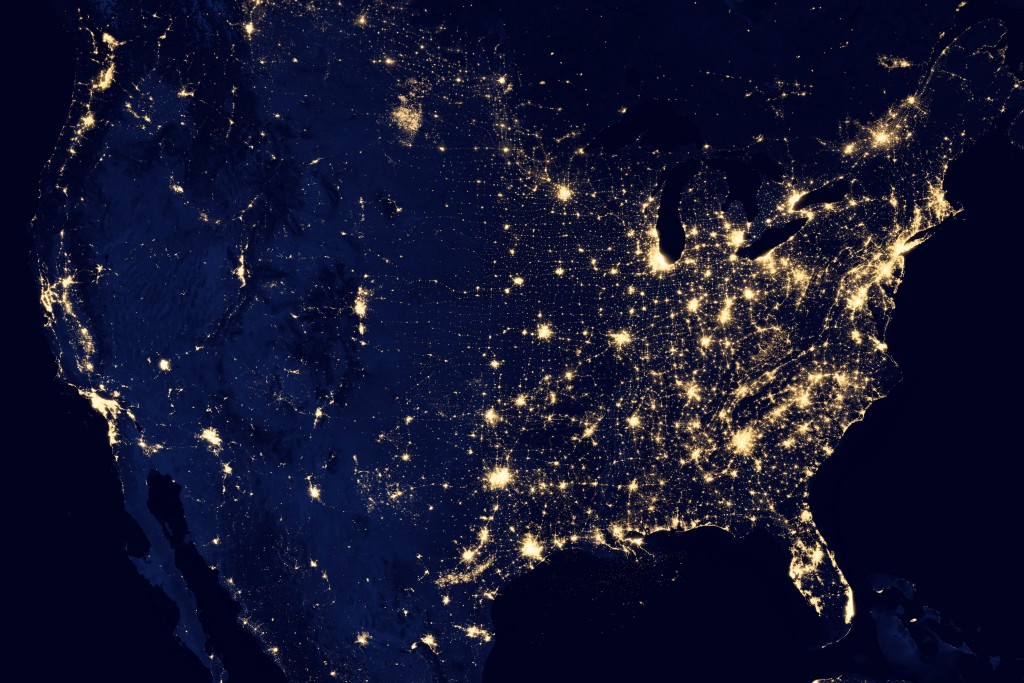
A human being is a part of the whole, called by us “Universe,” a part limited in time and space. He experiences himself, his thoughts and feelings as something separate from the rest—a kind of optical delusion of his consciousness.
Albert Einstein, Fragment of a Letter, February 1950
Einstein on the Beach is an opera composed by Philip Glass in collaboration with Robert Wilson. It features a recurring sequence of three different aspects of space. The video below is from Act III, Scene 1, Trial-Prison (Prematurely air-conditioned supermarket). Requires sound.
Density and Rapidity was written by Philip J. Palin, September 2015